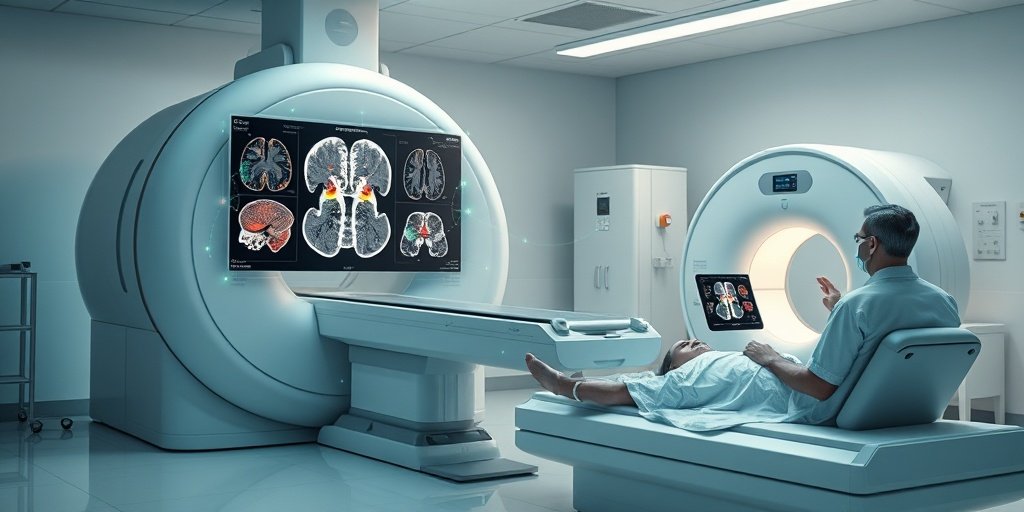⚡ Quick Summary
This study developed a deep learning model for the automatic segmentation and differential diagnosis of nasopharyngeal carcinoma (NPC) and nasopharyngeal lymphoma (NPL) using conventional MRI. The model achieved a remarkable DICE score of 0.876 and an AUC of 0.93 for the best-performing dataset, indicating its potential for enhancing early diagnosis and treatment.
🔍 Key Details
- 📊 Dataset: 142 patients with NPL and 292 patients with NPC
- 🧩 MRI Techniques: T1 weighted images (T1WI), T2 weighted images (T2WI), T1 weighted contrast-enhanced images (T1CE)
- ⚙️ Technology: ImageNet-pretrained ResNet101 model
- 🏆 Performance: DICE score of 0.876; AUC values: T1WI 0.78, T2WI 0.75, T1CE 0.84, T1WI+T2WI 0.93
🔑 Key Takeaways
- 🤖 Deep learning can significantly improve the differentiation between NPC and NPL.
- 📈 The T1WI+T2WI combination model showed the highest diagnostic performance.
- 🧠 Grad-CAM analysis highlighted the central tumor region’s importance in classification.
- 👩⚕️ Clinician performance was also evaluated, with AUC values of 0.77 for junior and 0.84 for senior clinicians.
- 💡 Early diagnosis facilitated by this model may lead to improved patient outcomes.
- 🏥 Study conducted at Renmin Hospital of Wuhan University from June 2012 to February 2023.

📚 Background
Nasopharyngeal carcinoma (NPC) and nasopharyngeal lymphoma (NPL) are two distinct malignancies that can present similarly on imaging studies, making accurate diagnosis challenging. Traditional diagnostic methods often rely on subjective interpretation of MRI images, which can lead to misdiagnosis and delayed treatment. The integration of deep learning technologies into medical imaging holds promise for enhancing diagnostic accuracy and efficiency.
🗒️ Study
This retrospective study included a total of 434 patients who underwent conventional MRI at Renmin Hospital of Wuhan University. The researchers manually segmented MRI images from 80 patients to train a deep learning segmentation model. The model was then tested on various datasets, including T1WI, T2WI, T1CE, and a combination of T1WI and T2WI, to evaluate its performance in differentiating between NPC and NPL.
📈 Results
The segmentation model achieved a DICE score of 0.876 in the testing set, indicating high accuracy in segmenting the regions of interest. The classification models demonstrated varying AUC values, with the T1WI+T2WI combination model achieving the highest AUC of 0.93. These results suggest that the deep learning model can effectively assist in the differential diagnosis of NPC and NPL based on conventional MRI.
🌍 Impact and Implications
The findings from this study could have significant implications for clinical practice. By utilizing a deep learning model for the early diagnosis of NPC and NPL, healthcare providers can facilitate timely and standardized treatment, potentially improving patient prognosis. This approach not only enhances diagnostic accuracy but also paves the way for the broader application of artificial intelligence in medical imaging.
🔮 Conclusion
This study highlights the transformative potential of deep learning in the field of medical imaging, particularly for differentiating between NPC and NPL. The impressive performance of the T1WI+T2WI combination model underscores the importance of integrating advanced technologies into diagnostic processes. Continued research in this area is essential to further refine these models and enhance their applicability in clinical settings.
💬 Your comments
What are your thoughts on the use of deep learning for improving cancer diagnosis? We would love to hear your insights! 💬 Leave your comments below or connect with us on social media:
[A deep learning method for differentiating nasopharyngeal carcinoma and lymphoma based on MRI].
Abstract
Objective:To development a deep learning(DL) model based on conventional MRI for automatic segmentation and differential diagnosis of nasopharyngeal carcinoma(NPC) and nasopharyngeal lymphoma(NPL). Methods:The retrospective study included 142 patients with NPL and 292 patients with NPC who underwent conventional MRI at Renmin Hospital of Wuhan University from June 2012 to February 2023. MRI from 80 patients were manually segmented to train the segmentation model. The automatically segmented regions of interest(ROIs) formed four datasets: T1 weighted images(T1WI), T2 weighted images(T2WI), T1 weighted contrast-enhanced images(T1CE), and a combination of T1WI and T2WI. The ImageNet-pretrained ResNet101 model was fine-tuned for the classification task. Statistical analysis was conducted using SPSS 22.0. The Dice coefficient loss was used to evaluate performance of segmentation task. Diagnostic performance was assessed using receiver operating characteristic(ROC) curves. Gradient-weighted class activation mapping(Grad-CAM) was imported to visualize the model’s function. Results:The DICE score of the segmentation model reached 0.876 in the testing set. The AUC values of classification models in testing set were as follows: T1WI: 0.78(95%CI 0.67-0.81), T2WI: 0.75(95%CI 0.72-0.86), T1CE: 0.84(95%CI 0.76-0.87), and T1WI+T2WI: 0.93(95%CI 0.85-0.94). The AUC values for the two clinicians were 0.77(95%CI 0.72-0.82) for the junior, and 0.84(95%CI 0.80-0.89) for the senior. Grad-CAM analysis revealed that the central region of the tumor was highly correlated with the model’s classification decisions, while the correlation was lower in the peripheral regions. Conclusion:The deep learning model performed well in differentiating NPC from NPL based on conventional MRI. The T1WI+T2WI combination model exhibited the best performance. The model can assist in the early diagnosis of NPC and NPL, facilitating timely and standardized treatment, which may improve patient prognosis.
Author: [‘Tang Y’, ‘Hua H’, ‘Wang Y’, ‘Tao Z’]
Journal: Lin Chuang Er Bi Yan Hou Tou Jing Wai Ke Za Zhi
Citation: Tang Y, et al. [A deep learning method for differentiating nasopharyngeal carcinoma and lymphoma based on MRI]. [A deep learning method for differentiating nasopharyngeal carcinoma and lymphoma based on MRI]. 2025; 39:597-602;609. doi: 10.13201/j.issn.2096-7993.2025.07.001